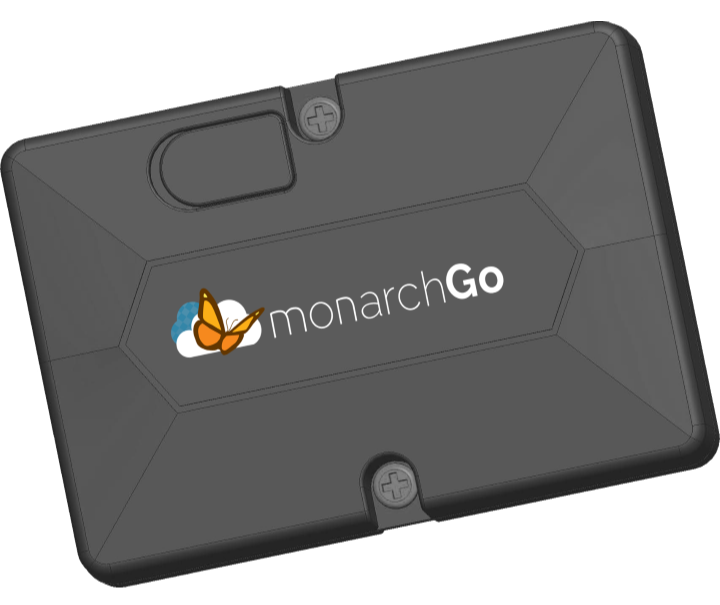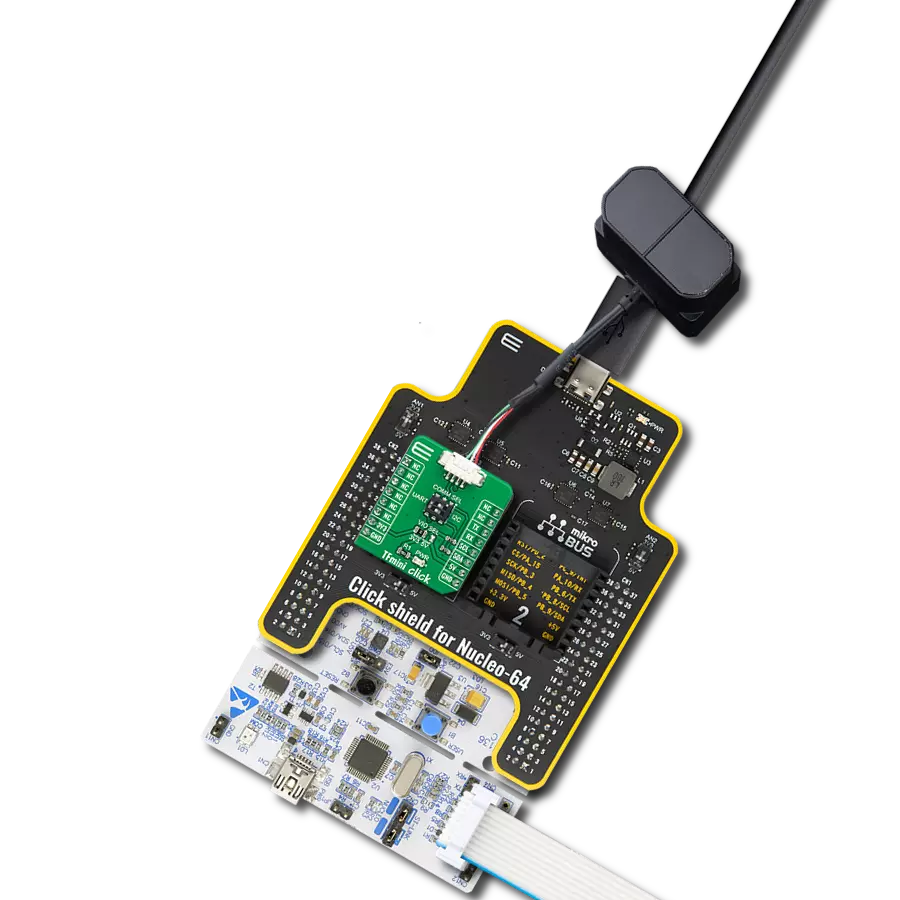Prototype an IoT app via this adapter solution, and send it to the cloud using a Monarch Go modem and a SIM card
A
A
Hardware Overview
How does it work?
Monarch Adapter Click is an adapter Click board™ intended to help customers to integrate and test their application based on Monarch Go successfully. This Click adapter communicates with your device through a serial UART interface and can exchange data with a cloud server using the Verizon LTE network. Monarch Go LTE-M modem's UART and GPIO pins are connected to one side of the level shifter, while the other side (Shifted) is connected to the respective mikroBUS™ UART and GPIO pins. However, the Monarch Go LTE-M modem series module is designed as the traditional DCE device (Data Communication Equipment), offering the full UART pin count, including the hardware flow control pins (CTS, RTS). These pins are routed to the mikroBUS™ CS (RTS) and the INT pin (CTS) and can be
used in the MCU software if the hardware flow control is needed. Digital sections of the Monarch Go LTE-M modem are internally supplied by 1.8V, so it is necessary to condition the communication bus lines which connect the host MCU with the module. The Monarch Adapter Click provides internal 1.8V via BH18PB1WHFV LDO regulator from Rohm Semiconductor, output from its internal LDO regulator, providing a needed reference voltage for one side of the TXB0106, a 6bit bidirectional level shifting and voltage translator with automatic direction sensing, from Texas Instruments. The reference voltage for the other side of the level shifter is taken from the onboard VCC SEL SMD jumper used to select between the mikroBUS™ power rails, depending on the used MCU
type and its logic voltage level requirements. Monarch GO, and Monarch GO-GPS are certified for use on the Verizon network (LTE band 13) with a roadmap for global band support. The monarch module is not delivered as part of the Click board™ package. Please read the Monarch GO module specification for more information about module features. This Click board™ can operate with either 3.3V or 5V logic voltage levels selected via the VCC SEL jumper. This way, both 3.3V and 5V capable MCUs can use the communication lines properly. However, the Click board™ comes equipped with a library containing easy-to-use functions and an example code that can be used, as a reference, for further development.
Features overview
Development board
Arduino UNO is a versatile microcontroller board built around the ATmega328P chip. It offers extensive connectivity options for various projects, featuring 14 digital input/output pins, six of which are PWM-capable, along with six analog inputs. Its core components include a 16MHz ceramic resonator, a USB connection, a power jack, an
ICSP header, and a reset button, providing everything necessary to power and program the board. The Uno is ready to go, whether connected to a computer via USB or powered by an AC-to-DC adapter or battery. As the first USB Arduino board, it serves as the benchmark for the Arduino platform, with "Uno" symbolizing its status as the
first in a series. This name choice, meaning "one" in Italian, commemorates the launch of Arduino Software (IDE) 1.0. Initially introduced alongside version 1.0 of the Arduino Software (IDE), the Uno has since become the foundational model for subsequent Arduino releases, embodying the platform's evolution.
Microcontroller Overview
MCU Card / MCU

Architecture
AVR
MCU Memory (KB)
32
Silicon Vendor
Microchip
Pin count
28
RAM (Bytes)
2048
You complete me!
Accessories
Click Shield for Arduino UNO has two proprietary mikroBUS™ sockets, allowing all the Click board™ devices to be interfaced with the Arduino UNO board without effort. The Arduino Uno, a microcontroller board based on the ATmega328P, provides an affordable and flexible way for users to try out new concepts and build prototypes with the ATmega328P microcontroller from various combinations of performance, power consumption, and features. The Arduino Uno has 14 digital input/output pins (of which six can be used as PWM outputs), six analog inputs, a 16 MHz ceramic resonator (CSTCE16M0V53-R0), a USB connection, a power jack, an ICSP header, and reset button. Most of the ATmega328P microcontroller pins are brought to the IO pins on the left and right edge of the board, which are then connected to two existing mikroBUS™ sockets. This Click Shield also has several switches that perform functions such as selecting the logic levels of analog signals on mikroBUS™ sockets and selecting logic voltage levels of the mikroBUS™ sockets themselves. Besides, the user is offered the possibility of using any Click board™ with the help of existing bidirectional level-shifting voltage translators, regardless of whether the Click board™ operates at a 3.3V or 5V logic voltage level. Once you connect the Arduino UNO board with our Click Shield for Arduino UNO, you can access hundreds of Click boards™, working with 3.3V or 5V logic voltage levels.
Monarch Go presents your all-in-one solution for streamlined IoT connectivity. This comprehensive LTE-M modem component is a game-changer for device makers, offering the quickest path to market and the lowest total cost of ownership (TCO). Monarch Go eliminates the complexities of designing and tuning a cellular antenna, thanks to its embedded optimized LTE antenna, certified by Verizon. Designed for seamless integration, Monarch Go comes equipped with a pre-installed ThingSpace IoT SIM, ensuring hassle-free connectivity on Verizon's network. Plug it in and go – no intricate setup required. The device boasts a compact design with dimensions of 35mm x 50mm x 14.95mm, making it perfect for space-conscious IoT applications. With high-speed UART as the primary data and AT command interface, Monarch Go facilitates easy connections to third-party cloud services.

Used MCU Pins
mikroBUS™ mapper
Take a closer look
Click board™ Schematic

Step by step
Project assembly
Track your results in real time
Application Output
1. Application Output - In Debug mode, the 'Application Output' window enables real-time data monitoring, offering direct insight into execution results. Ensure proper data display by configuring the environment correctly using the provided tutorial.

2. UART Terminal - Use the UART Terminal to monitor data transmission via a USB to UART converter, allowing direct communication between the Click board™ and your development system. Configure the baud rate and other serial settings according to your project's requirements to ensure proper functionality. For step-by-step setup instructions, refer to the provided tutorial.

3. Plot Output - The Plot feature offers a powerful way to visualize real-time sensor data, enabling trend analysis, debugging, and comparison of multiple data points. To set it up correctly, follow the provided tutorial, which includes a step-by-step example of using the Plot feature to display Click board™ readings. To use the Plot feature in your code, use the function: plot(*insert_graph_name*, variable_name);. This is a general format, and it is up to the user to replace 'insert_graph_name' with the actual graph name and 'variable_name' with the parameter to be displayed.

Software Support
Library Description
This library contains API for Monarch Adapter Click driver.
Key functions:
void monarch_send_command( uint8_t *cmd_buf, uint8_t len )- Send command function
Open Source
Code example
The complete application code and a ready-to-use project are available through the NECTO Studio Package Manager for direct installation in the NECTO Studio. The application code can also be found on the MIKROE GitHub account.
/*!
* \file
* \brief MonarchAdapter Click example
*
* # Description
* This example reads and processes data from Monarch Adapter Clicks.
*
* The demo application is composed of two sections :
*
* ## Application Init
* Initializes the driver and checks the module firmware revision.
*
* ## Application Task
* Checks EPS Network Registration Status (+CEREG) every 3 seconds.
*
* ## Additional Function
* - monarchadapter_process ( ) - The general process of collecting data the module sends.
*
* @note
* Monarch GO and Monarch GO-GPS are certified for use on the Verizon network (LTE band 13)
* with roadmap for global band support. Monarch module is not delivered as part of
* the Click board package. For more information about module features please read
* Monarch GO module specification.
*
* \author MikroE Team
*
*/
// ------------------------------------------------------------------- INCLUDES
#include "board.h"
#include "log.h"
#include "monarchadapter.h"
#include "string.h"
#define PROCESS_COUNTER 50
#define PROCESS_RX_BUFFER_SIZE 600
#define PROCESS_PARSER_BUFFER_SIZE 600
#define MONARCH_CMD_AT "AT"
#define MONARCH_CMD_ATE1 "ATE1"
#define MONARCH_CMD_ATI "ATI"
#define MONARCH_CMD_ATI1 "ATI1"
#define MONARCH_CMD_CEREG "AT+CEREG?"
// ------------------------------------------------------------------ VARIABLES
static monarchadapter_t monarchadapter;
static log_t logger;
static char current_parser_buf[ PROCESS_PARSER_BUFFER_SIZE ];
// ------------------------------------------------------- ADDITIONAL FUNCTIONS
static void monarchadapter_process ( void )
{
int32_t rsp_size;
uint16_t rsp_cnt = 0;
char uart_rx_buffer[ PROCESS_RX_BUFFER_SIZE ] = { 0 };
uint16_t check_buf_cnt;
uint8_t process_cnt = PROCESS_COUNTER;
// Clear parser buffer
memset( current_parser_buf, 0 , PROCESS_PARSER_BUFFER_SIZE );
while( process_cnt != 0 )
{
rsp_size = monarchadapter_generic_read( &monarchadapter, &uart_rx_buffer, PROCESS_RX_BUFFER_SIZE );
if ( rsp_size > 0 )
{
// Validation of the received data
for ( check_buf_cnt = 0; check_buf_cnt < rsp_size; check_buf_cnt++ )
{
if ( uart_rx_buffer[ check_buf_cnt ] == 0 )
{
uart_rx_buffer[ check_buf_cnt ] = 13;
}
}
// Storages data in parser buffer
rsp_cnt += rsp_size;
if ( rsp_cnt < PROCESS_PARSER_BUFFER_SIZE )
{
strncat( current_parser_buf, uart_rx_buffer, rsp_size );
}
process_cnt = 3;
// Clear RX buffer
memset( uart_rx_buffer, 0, PROCESS_RX_BUFFER_SIZE );
}
else
{
process_cnt--;
// Process delay
Delay_100ms( );
}
}
if ( rsp_cnt > 0 )
{
log_printf( &logger, "%s", current_parser_buf );
log_printf( &logger, "-----------------------------------\r\n" );
}
}
// ------------------------------------------------------ APPLICATION FUNCTIONS
void application_init ( void )
{
log_cfg_t log_cfg;
monarchadapter_cfg_t cfg;
/**
* Logger initialization.
* Default baud rate: 115200
* Default log level: LOG_LEVEL_DEBUG
* @note If USB_UART_RX and USB_UART_TX
* are defined as HAL_PIN_NC, you will
* need to define them manually for log to work.
* See @b LOG_MAP_USB_UART macro definition for detailed explanation.
*/
LOG_MAP_USB_UART( log_cfg );
log_init( &logger, &log_cfg );
log_info( &logger, "---- Application Init ----" );
// Click initialization.
monarchadapter_cfg_setup( &cfg );
MONARCHADAPTER_MAP_MIKROBUS( cfg, MIKROBUS_1 );
monarchadapter_init( &monarchadapter, &cfg );
monarchadapter_power_on( &monarchadapter );
monarchadapter_send_command( &monarchadapter, MONARCH_CMD_AT );
monarchadapter_process( );
monarchadapter_send_command( &monarchadapter, MONARCH_CMD_ATE1 );
monarchadapter_process( );
monarchadapter_send_command( &monarchadapter, MONARCH_CMD_ATI );
monarchadapter_process( );
monarchadapter_send_command( &monarchadapter, MONARCH_CMD_ATI1 );
monarchadapter_process( );
}
void application_task ( void )
{
monarchadapter_send_command( &monarchadapter, MONARCH_CMD_CEREG );
monarchadapter_process( );
Delay_ms ( 1000 );
Delay_ms ( 1000 );
Delay_ms ( 1000 );
}
int main ( void )
{
/* Do not remove this line or clock might not be set correctly. */
#ifdef PREINIT_SUPPORTED
preinit();
#endif
application_init( );
for ( ; ; )
{
application_task( );
}
return 0;
}
// ------------------------------------------------------------------------ END
Additional Support
Resources
Category:Adapter


































